MGT5STR: Strategic Management and AACo's International Expansion
VerifiedAdded on 2023/03/23
|14
|3014
|62
Report
AI Summary
This report provides a strategic analysis of Australian Agricultural Company (AACo) and its potential international expansion, with a focus on entering the Chinese market. It begins with an overview of the Australian food-focused agribusiness sector and identifies international opportunities for AACo, emphasizing increased market share and revenue. The report then employs Porter's Diamond model and PESTLE analysis to assess the attractiveness and challenges of the Chinese market, considering factors like factor conditions, supporting industries, demand conditions, political, economic, social, technological, environmental, and legal aspects. It suggests global and transnational strategies as suitable approaches and recommends a joint venture as the most appropriate market entry mode, while advising against direct exporting. The report concludes that China is a potential host market for AACo and recommends partnering with a local firm to gain market insights and mitigate risks.
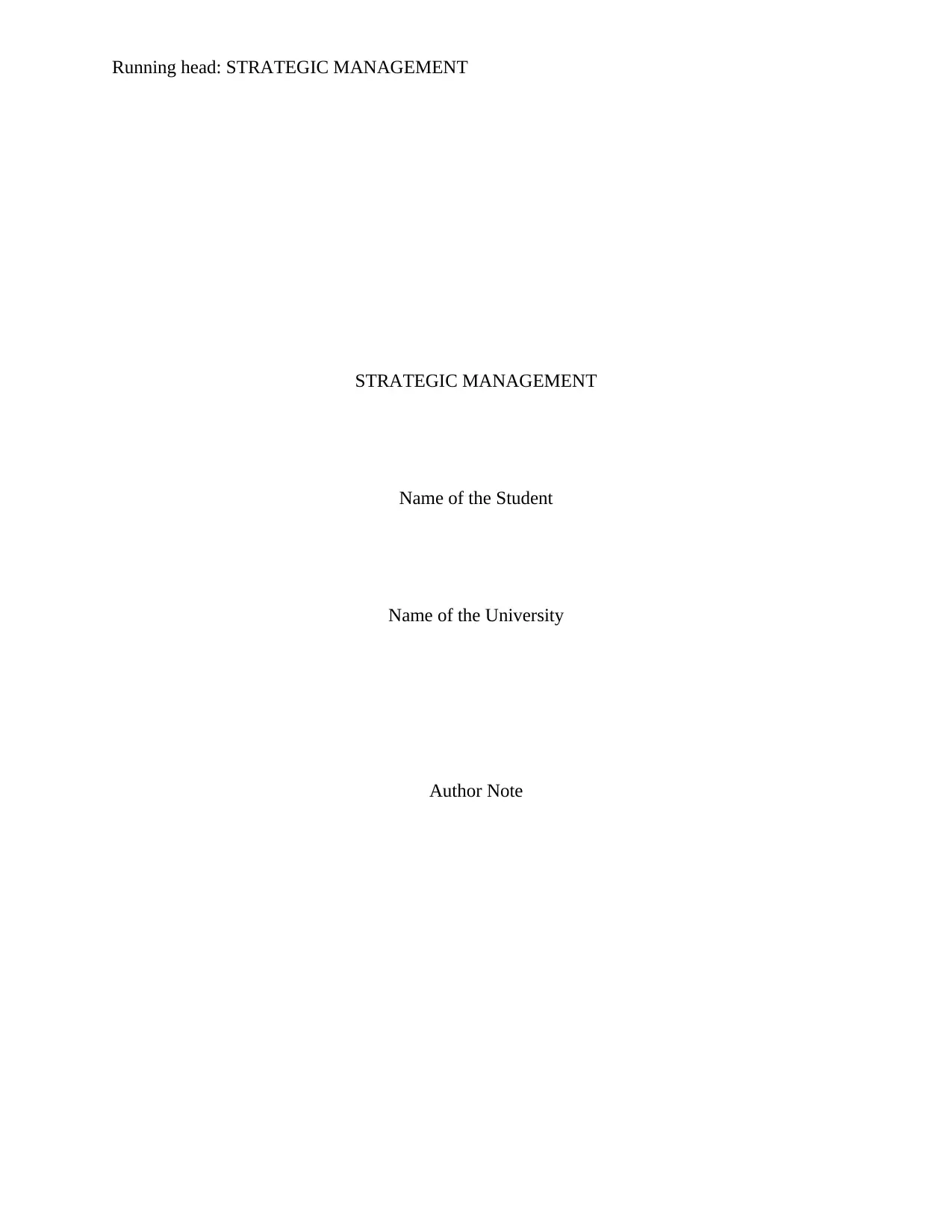
Running head: STRATEGIC MANAGEMENT
STRATEGIC MANAGEMENT
Name of the Student
Name of the University
Author Note
STRATEGIC MANAGEMENT
Name of the Student
Name of the University
Author Note
Paraphrase This Document
Need a fresh take? Get an instant paraphrase of this document with our AI Paraphraser
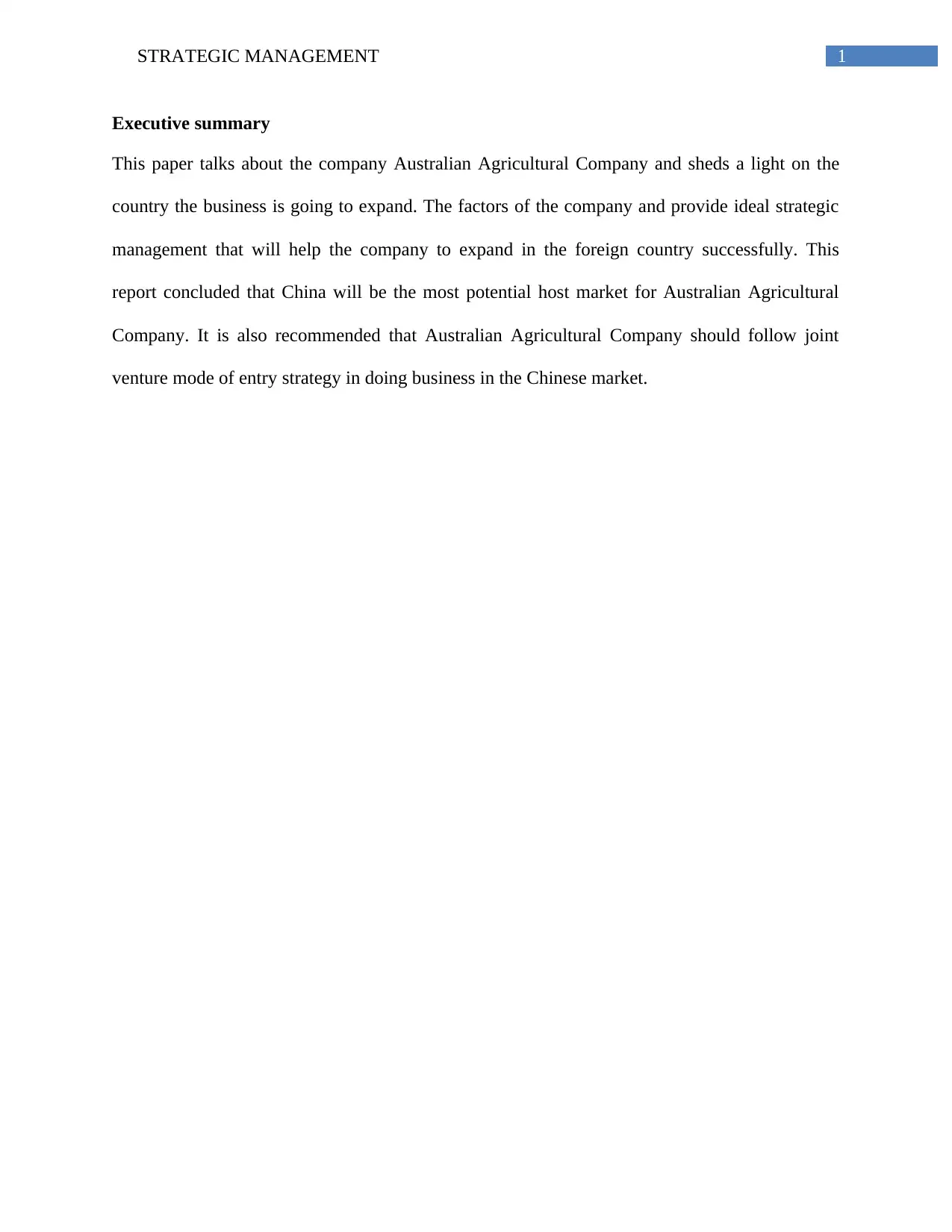
1STRATEGIC MANAGEMENT
Executive summary
This paper talks about the company Australian Agricultural Company and sheds a light on the
country the business is going to expand. The factors of the company and provide ideal strategic
management that will help the company to expand in the foreign country successfully. This
report concluded that China will be the most potential host market for Australian Agricultural
Company. It is also recommended that Australian Agricultural Company should follow joint
venture mode of entry strategy in doing business in the Chinese market.
Executive summary
This paper talks about the company Australian Agricultural Company and sheds a light on the
country the business is going to expand. The factors of the company and provide ideal strategic
management that will help the company to expand in the foreign country successfully. This
report concluded that China will be the most potential host market for Australian Agricultural
Company. It is also recommended that Australian Agricultural Company should follow joint
venture mode of entry strategy in doing business in the Chinese market.
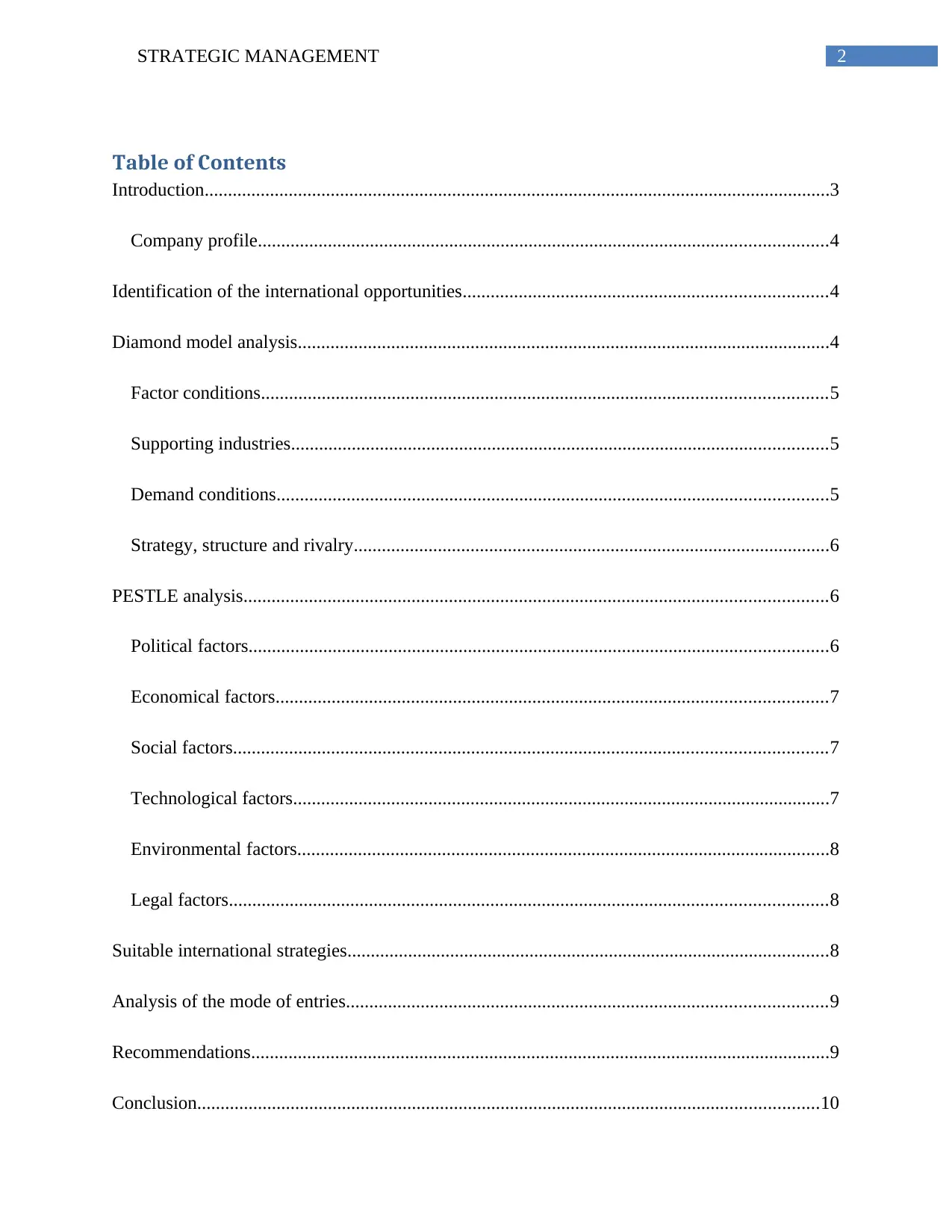
2STRATEGIC MANAGEMENT
Table of Contents
Introduction......................................................................................................................................3
Company profile..........................................................................................................................4
Identification of the international opportunities..............................................................................4
Diamond model analysis..................................................................................................................4
Factor conditions.........................................................................................................................5
Supporting industries...................................................................................................................5
Demand conditions......................................................................................................................5
Strategy, structure and rivalry......................................................................................................6
PESTLE analysis.............................................................................................................................6
Political factors............................................................................................................................6
Economical factors......................................................................................................................7
Social factors...............................................................................................................................7
Technological factors...................................................................................................................7
Environmental factors..................................................................................................................8
Legal factors................................................................................................................................8
Suitable international strategies.......................................................................................................8
Analysis of the mode of entries.......................................................................................................9
Recommendations............................................................................................................................9
Conclusion.....................................................................................................................................10
Table of Contents
Introduction......................................................................................................................................3
Company profile..........................................................................................................................4
Identification of the international opportunities..............................................................................4
Diamond model analysis..................................................................................................................4
Factor conditions.........................................................................................................................5
Supporting industries...................................................................................................................5
Demand conditions......................................................................................................................5
Strategy, structure and rivalry......................................................................................................6
PESTLE analysis.............................................................................................................................6
Political factors............................................................................................................................6
Economical factors......................................................................................................................7
Social factors...............................................................................................................................7
Technological factors...................................................................................................................7
Environmental factors..................................................................................................................8
Legal factors................................................................................................................................8
Suitable international strategies.......................................................................................................8
Analysis of the mode of entries.......................................................................................................9
Recommendations............................................................................................................................9
Conclusion.....................................................................................................................................10
⊘ This is a preview!⊘
Do you want full access?
Subscribe today to unlock all pages.

Trusted by 1+ million students worldwide
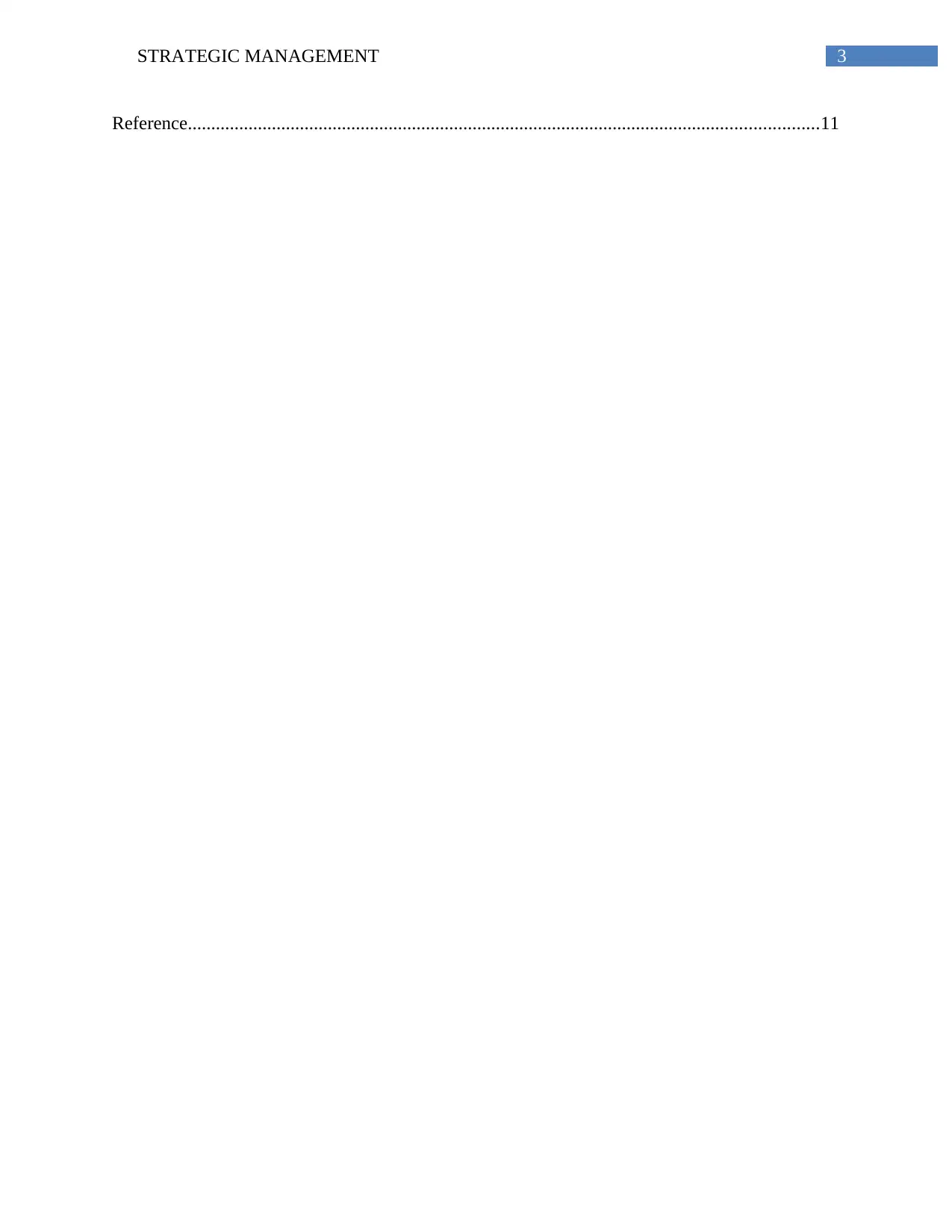
3STRATEGIC MANAGEMENT
Reference.......................................................................................................................................11
Reference.......................................................................................................................................11
Paraphrase This Document
Need a fresh take? Get an instant paraphrase of this document with our AI Paraphraser
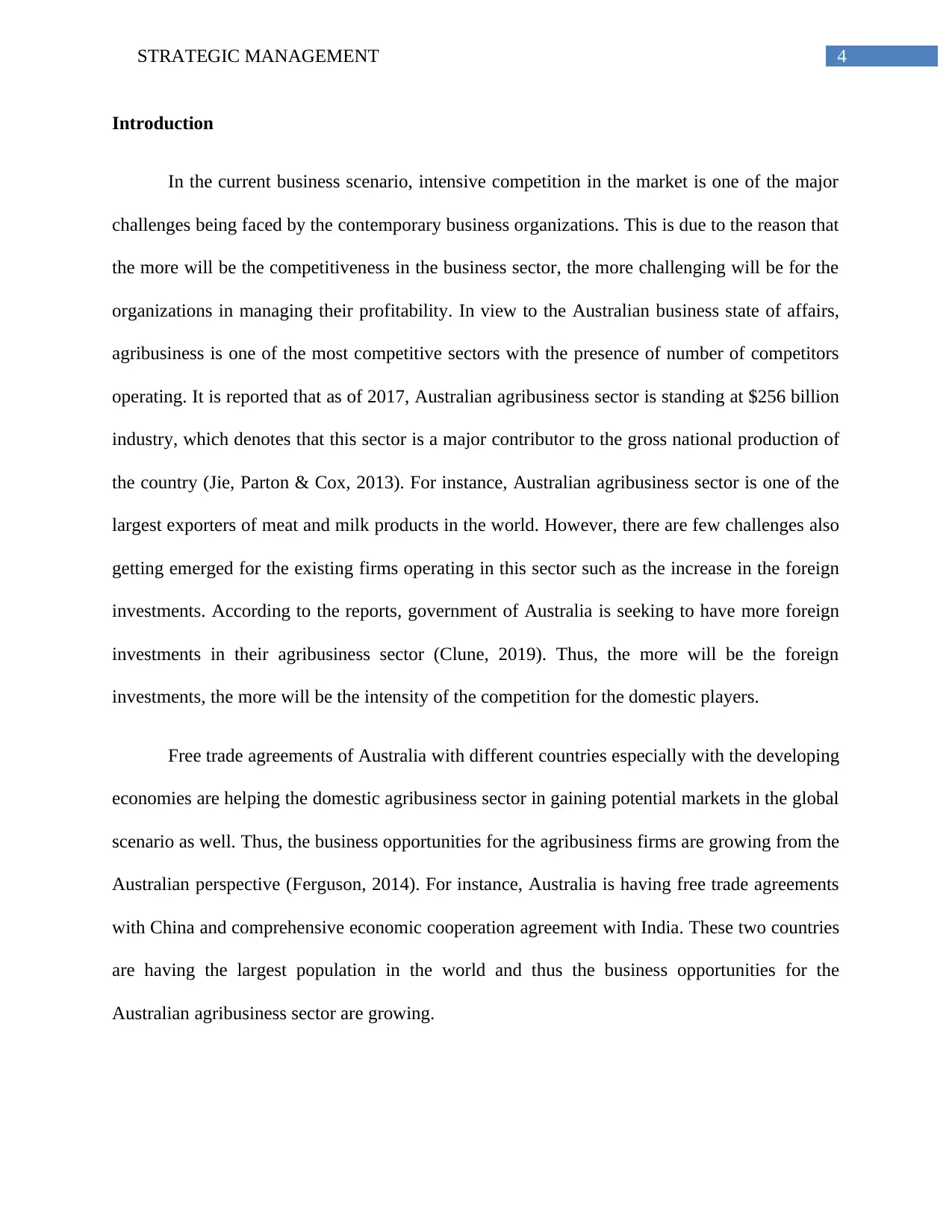
4STRATEGIC MANAGEMENT
Introduction
In the current business scenario, intensive competition in the market is one of the major
challenges being faced by the contemporary business organizations. This is due to the reason that
the more will be the competitiveness in the business sector, the more challenging will be for the
organizations in managing their profitability. In view to the Australian business state of affairs,
agribusiness is one of the most competitive sectors with the presence of number of competitors
operating. It is reported that as of 2017, Australian agribusiness sector is standing at $256 billion
industry, which denotes that this sector is a major contributor to the gross national production of
the country (Jie, Parton & Cox, 2013). For instance, Australian agribusiness sector is one of the
largest exporters of meat and milk products in the world. However, there are few challenges also
getting emerged for the existing firms operating in this sector such as the increase in the foreign
investments. According to the reports, government of Australia is seeking to have more foreign
investments in their agribusiness sector (Clune, 2019). Thus, the more will be the foreign
investments, the more will be the intensity of the competition for the domestic players.
Free trade agreements of Australia with different countries especially with the developing
economies are helping the domestic agribusiness sector in gaining potential markets in the global
scenario as well. Thus, the business opportunities for the agribusiness firms are growing from the
Australian perspective (Ferguson, 2014). For instance, Australia is having free trade agreements
with China and comprehensive economic cooperation agreement with India. These two countries
are having the largest population in the world and thus the business opportunities for the
Australian agribusiness sector are growing.
Introduction
In the current business scenario, intensive competition in the market is one of the major
challenges being faced by the contemporary business organizations. This is due to the reason that
the more will be the competitiveness in the business sector, the more challenging will be for the
organizations in managing their profitability. In view to the Australian business state of affairs,
agribusiness is one of the most competitive sectors with the presence of number of competitors
operating. It is reported that as of 2017, Australian agribusiness sector is standing at $256 billion
industry, which denotes that this sector is a major contributor to the gross national production of
the country (Jie, Parton & Cox, 2013). For instance, Australian agribusiness sector is one of the
largest exporters of meat and milk products in the world. However, there are few challenges also
getting emerged for the existing firms operating in this sector such as the increase in the foreign
investments. According to the reports, government of Australia is seeking to have more foreign
investments in their agribusiness sector (Clune, 2019). Thus, the more will be the foreign
investments, the more will be the intensity of the competition for the domestic players.
Free trade agreements of Australia with different countries especially with the developing
economies are helping the domestic agribusiness sector in gaining potential markets in the global
scenario as well. Thus, the business opportunities for the agribusiness firms are growing from the
Australian perspective (Ferguson, 2014). For instance, Australia is having free trade agreements
with China and comprehensive economic cooperation agreement with India. These two countries
are having the largest population in the world and thus the business opportunities for the
Australian agribusiness sector are growing.
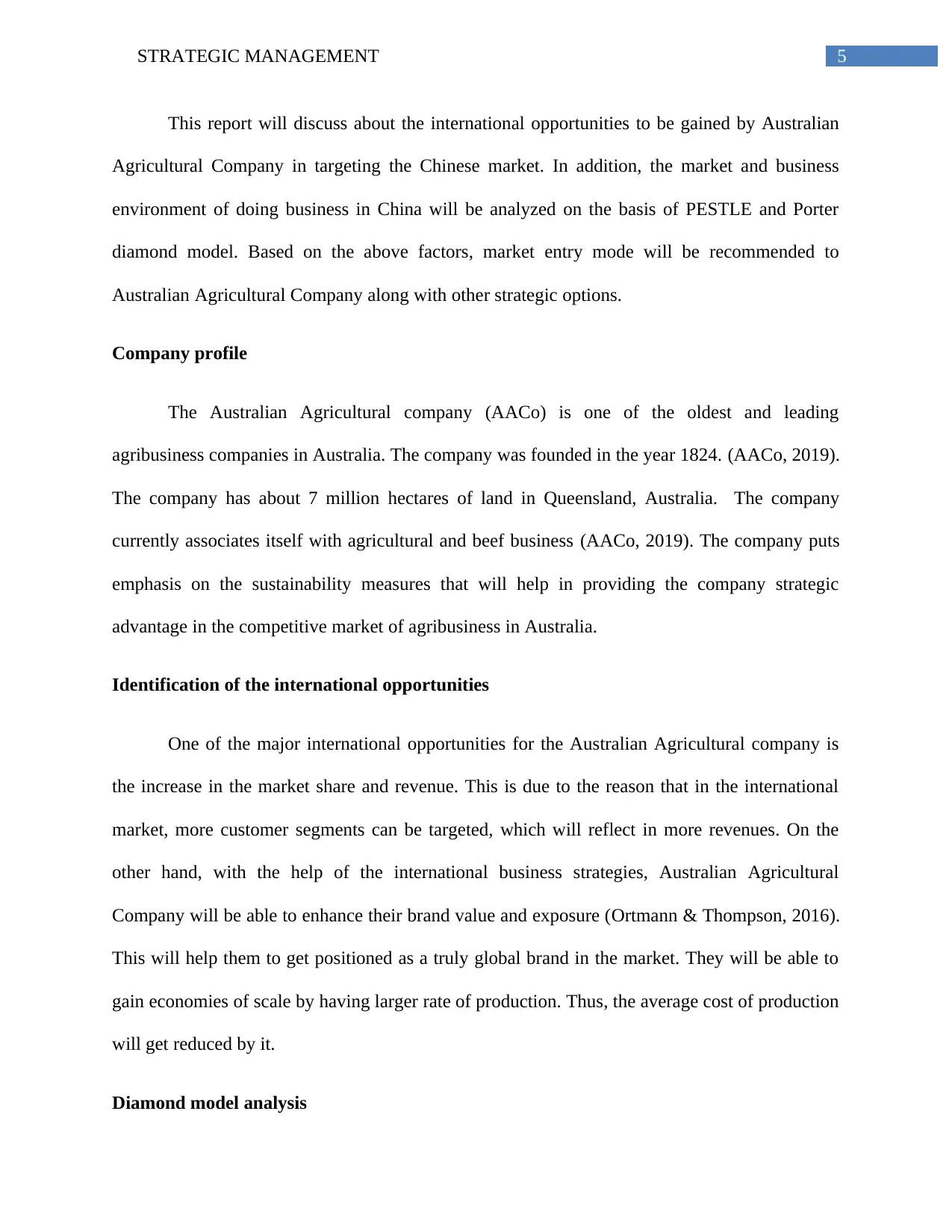
5STRATEGIC MANAGEMENT
This report will discuss about the international opportunities to be gained by Australian
Agricultural Company in targeting the Chinese market. In addition, the market and business
environment of doing business in China will be analyzed on the basis of PESTLE and Porter
diamond model. Based on the above factors, market entry mode will be recommended to
Australian Agricultural Company along with other strategic options.
Company profile
The Australian Agricultural company (AACo) is one of the oldest and leading
agribusiness companies in Australia. The company was founded in the year 1824. (AACo, 2019).
The company has about 7 million hectares of land in Queensland, Australia. The company
currently associates itself with agricultural and beef business (AACo, 2019). The company puts
emphasis on the sustainability measures that will help in providing the company strategic
advantage in the competitive market of agribusiness in Australia.
Identification of the international opportunities
One of the major international opportunities for the Australian Agricultural company is
the increase in the market share and revenue. This is due to the reason that in the international
market, more customer segments can be targeted, which will reflect in more revenues. On the
other hand, with the help of the international business strategies, Australian Agricultural
Company will be able to enhance their brand value and exposure (Ortmann & Thompson, 2016).
This will help them to get positioned as a truly global brand in the market. They will be able to
gain economies of scale by having larger rate of production. Thus, the average cost of production
will get reduced by it.
Diamond model analysis
This report will discuss about the international opportunities to be gained by Australian
Agricultural Company in targeting the Chinese market. In addition, the market and business
environment of doing business in China will be analyzed on the basis of PESTLE and Porter
diamond model. Based on the above factors, market entry mode will be recommended to
Australian Agricultural Company along with other strategic options.
Company profile
The Australian Agricultural company (AACo) is one of the oldest and leading
agribusiness companies in Australia. The company was founded in the year 1824. (AACo, 2019).
The company has about 7 million hectares of land in Queensland, Australia. The company
currently associates itself with agricultural and beef business (AACo, 2019). The company puts
emphasis on the sustainability measures that will help in providing the company strategic
advantage in the competitive market of agribusiness in Australia.
Identification of the international opportunities
One of the major international opportunities for the Australian Agricultural company is
the increase in the market share and revenue. This is due to the reason that in the international
market, more customer segments can be targeted, which will reflect in more revenues. On the
other hand, with the help of the international business strategies, Australian Agricultural
Company will be able to enhance their brand value and exposure (Ortmann & Thompson, 2016).
This will help them to get positioned as a truly global brand in the market. They will be able to
gain economies of scale by having larger rate of production. Thus, the average cost of production
will get reduced by it.
Diamond model analysis
⊘ This is a preview!⊘
Do you want full access?
Subscribe today to unlock all pages.

Trusted by 1+ million students worldwide
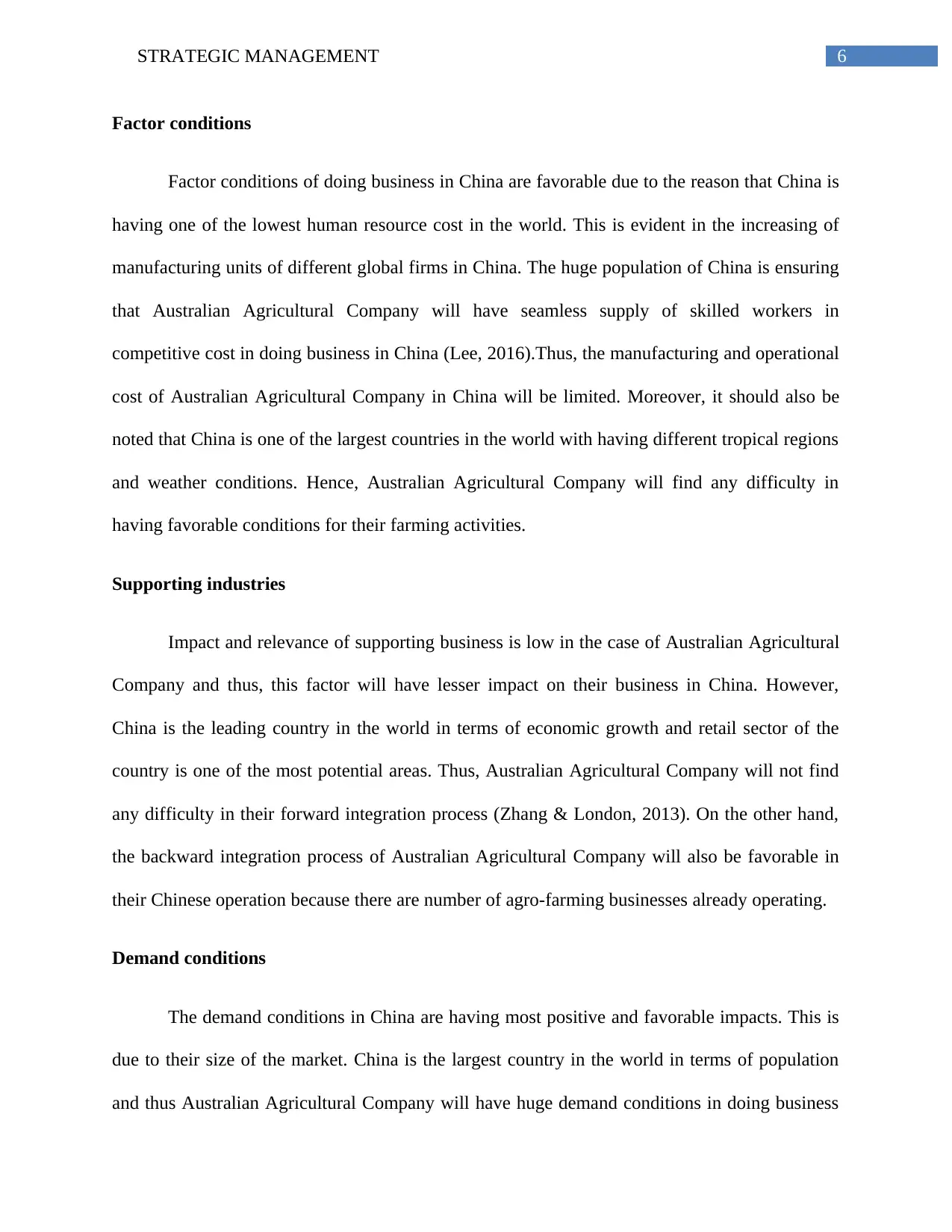
6STRATEGIC MANAGEMENT
Factor conditions
Factor conditions of doing business in China are favorable due to the reason that China is
having one of the lowest human resource cost in the world. This is evident in the increasing of
manufacturing units of different global firms in China. The huge population of China is ensuring
that Australian Agricultural Company will have seamless supply of skilled workers in
competitive cost in doing business in China (Lee, 2016).Thus, the manufacturing and operational
cost of Australian Agricultural Company in China will be limited. Moreover, it should also be
noted that China is one of the largest countries in the world with having different tropical regions
and weather conditions. Hence, Australian Agricultural Company will find any difficulty in
having favorable conditions for their farming activities.
Supporting industries
Impact and relevance of supporting business is low in the case of Australian Agricultural
Company and thus, this factor will have lesser impact on their business in China. However,
China is the leading country in the world in terms of economic growth and retail sector of the
country is one of the most potential areas. Thus, Australian Agricultural Company will not find
any difficulty in their forward integration process (Zhang & London, 2013). On the other hand,
the backward integration process of Australian Agricultural Company will also be favorable in
their Chinese operation because there are number of agro-farming businesses already operating.
Demand conditions
The demand conditions in China are having most positive and favorable impacts. This is
due to their size of the market. China is the largest country in the world in terms of population
and thus Australian Agricultural Company will have huge demand conditions in doing business
Factor conditions
Factor conditions of doing business in China are favorable due to the reason that China is
having one of the lowest human resource cost in the world. This is evident in the increasing of
manufacturing units of different global firms in China. The huge population of China is ensuring
that Australian Agricultural Company will have seamless supply of skilled workers in
competitive cost in doing business in China (Lee, 2016).Thus, the manufacturing and operational
cost of Australian Agricultural Company in China will be limited. Moreover, it should also be
noted that China is one of the largest countries in the world with having different tropical regions
and weather conditions. Hence, Australian Agricultural Company will find any difficulty in
having favorable conditions for their farming activities.
Supporting industries
Impact and relevance of supporting business is low in the case of Australian Agricultural
Company and thus, this factor will have lesser impact on their business in China. However,
China is the leading country in the world in terms of economic growth and retail sector of the
country is one of the most potential areas. Thus, Australian Agricultural Company will not find
any difficulty in their forward integration process (Zhang & London, 2013). On the other hand,
the backward integration process of Australian Agricultural Company will also be favorable in
their Chinese operation because there are number of agro-farming businesses already operating.
Demand conditions
The demand conditions in China are having most positive and favorable impacts. This is
due to their size of the market. China is the largest country in the world in terms of population
and thus Australian Agricultural Company will have huge demand conditions in doing business
Paraphrase This Document
Need a fresh take? Get an instant paraphrase of this document with our AI Paraphraser
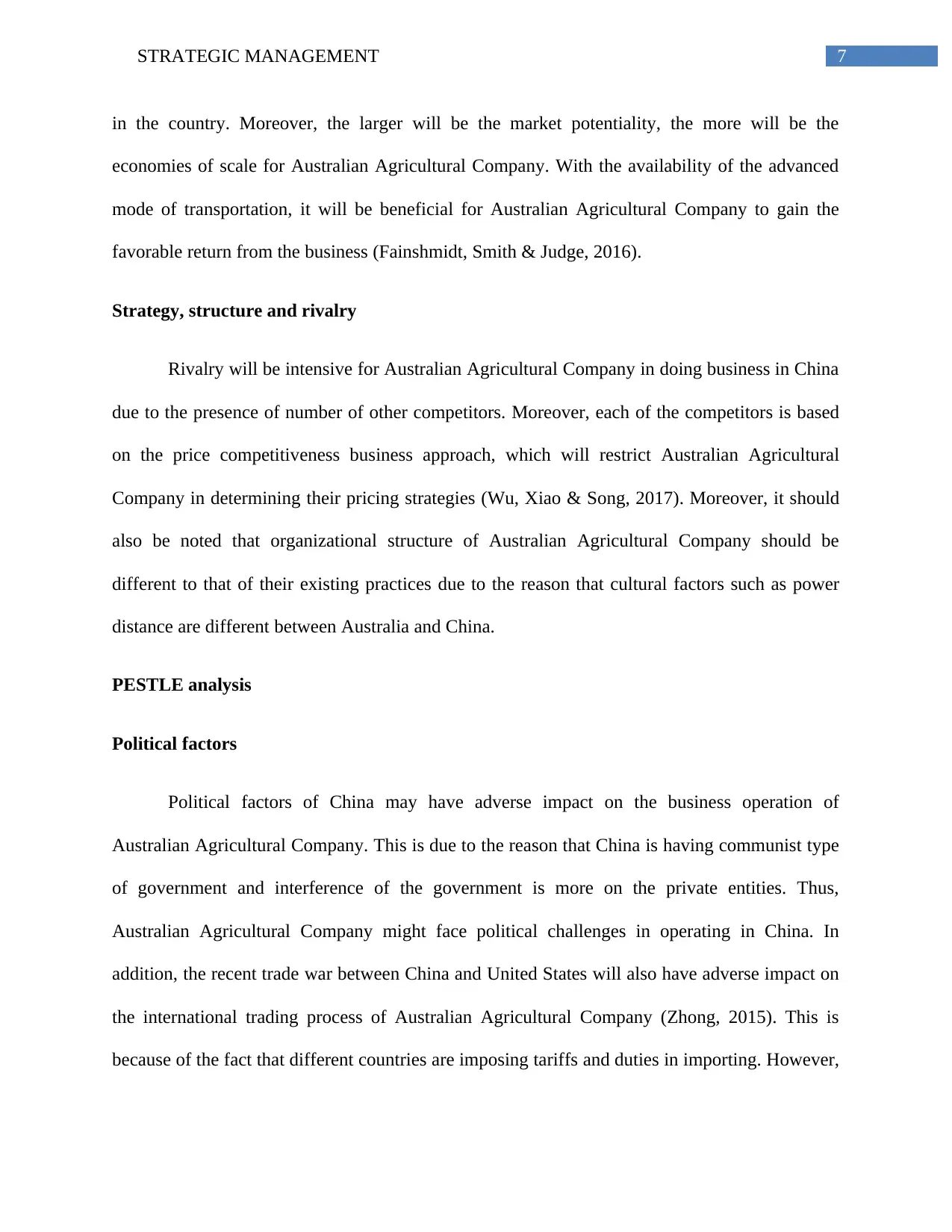
7STRATEGIC MANAGEMENT
in the country. Moreover, the larger will be the market potentiality, the more will be the
economies of scale for Australian Agricultural Company. With the availability of the advanced
mode of transportation, it will be beneficial for Australian Agricultural Company to gain the
favorable return from the business (Fainshmidt, Smith & Judge, 2016).
Strategy, structure and rivalry
Rivalry will be intensive for Australian Agricultural Company in doing business in China
due to the presence of number of other competitors. Moreover, each of the competitors is based
on the price competitiveness business approach, which will restrict Australian Agricultural
Company in determining their pricing strategies (Wu, Xiao & Song, 2017). Moreover, it should
also be noted that organizational structure of Australian Agricultural Company should be
different to that of their existing practices due to the reason that cultural factors such as power
distance are different between Australia and China.
PESTLE analysis
Political factors
Political factors of China may have adverse impact on the business operation of
Australian Agricultural Company. This is due to the reason that China is having communist type
of government and interference of the government is more on the private entities. Thus,
Australian Agricultural Company might face political challenges in operating in China. In
addition, the recent trade war between China and United States will also have adverse impact on
the international trading process of Australian Agricultural Company (Zhong, 2015). This is
because of the fact that different countries are imposing tariffs and duties in importing. However,
in the country. Moreover, the larger will be the market potentiality, the more will be the
economies of scale for Australian Agricultural Company. With the availability of the advanced
mode of transportation, it will be beneficial for Australian Agricultural Company to gain the
favorable return from the business (Fainshmidt, Smith & Judge, 2016).
Strategy, structure and rivalry
Rivalry will be intensive for Australian Agricultural Company in doing business in China
due to the presence of number of other competitors. Moreover, each of the competitors is based
on the price competitiveness business approach, which will restrict Australian Agricultural
Company in determining their pricing strategies (Wu, Xiao & Song, 2017). Moreover, it should
also be noted that organizational structure of Australian Agricultural Company should be
different to that of their existing practices due to the reason that cultural factors such as power
distance are different between Australia and China.
PESTLE analysis
Political factors
Political factors of China may have adverse impact on the business operation of
Australian Agricultural Company. This is due to the reason that China is having communist type
of government and interference of the government is more on the private entities. Thus,
Australian Agricultural Company might face political challenges in operating in China. In
addition, the recent trade war between China and United States will also have adverse impact on
the international trading process of Australian Agricultural Company (Zhong, 2015). This is
because of the fact that different countries are imposing tariffs and duties in importing. However,
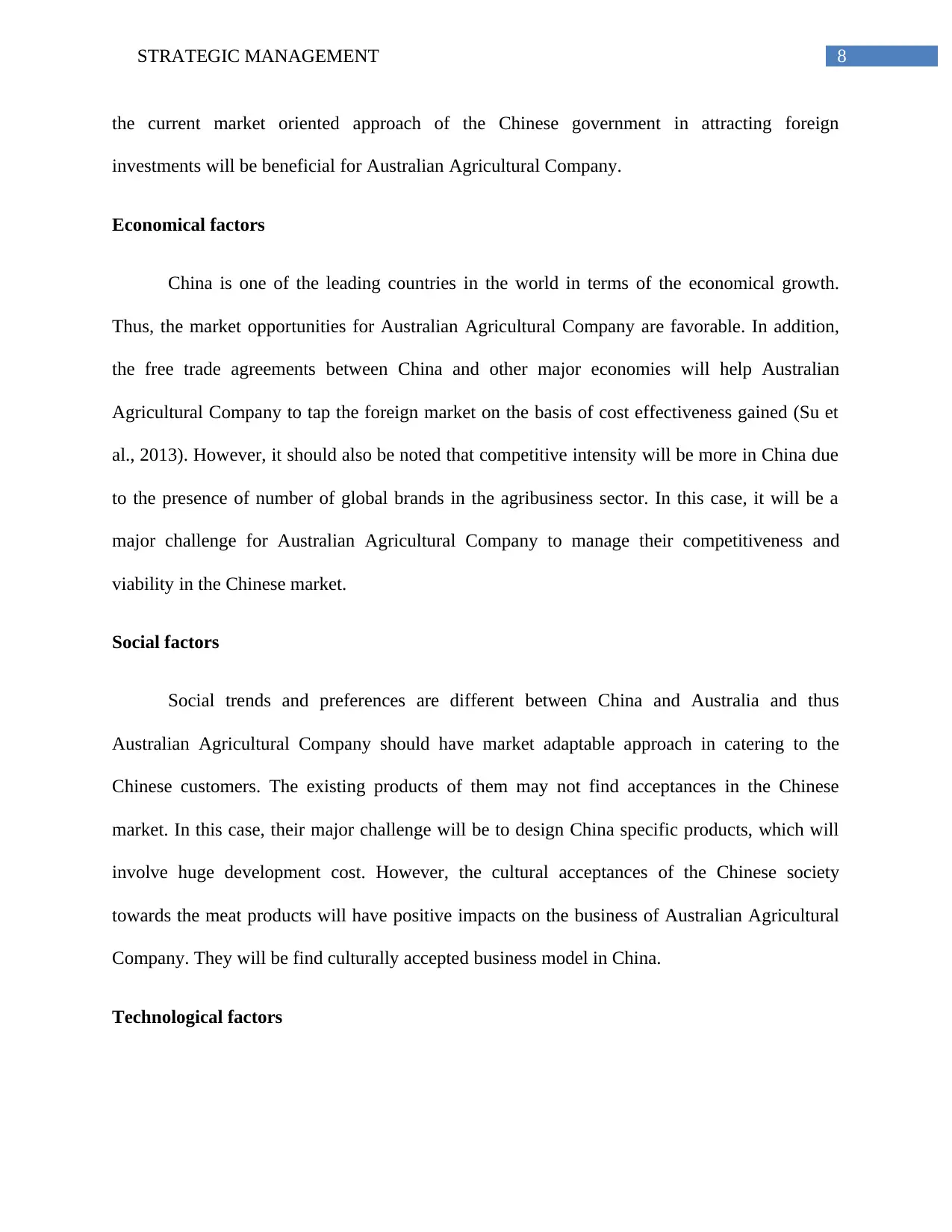
8STRATEGIC MANAGEMENT
the current market oriented approach of the Chinese government in attracting foreign
investments will be beneficial for Australian Agricultural Company.
Economical factors
China is one of the leading countries in the world in terms of the economical growth.
Thus, the market opportunities for Australian Agricultural Company are favorable. In addition,
the free trade agreements between China and other major economies will help Australian
Agricultural Company to tap the foreign market on the basis of cost effectiveness gained (Su et
al., 2013). However, it should also be noted that competitive intensity will be more in China due
to the presence of number of global brands in the agribusiness sector. In this case, it will be a
major challenge for Australian Agricultural Company to manage their competitiveness and
viability in the Chinese market.
Social factors
Social trends and preferences are different between China and Australia and thus
Australian Agricultural Company should have market adaptable approach in catering to the
Chinese customers. The existing products of them may not find acceptances in the Chinese
market. In this case, their major challenge will be to design China specific products, which will
involve huge development cost. However, the cultural acceptances of the Chinese society
towards the meat products will have positive impacts on the business of Australian Agricultural
Company. They will be find culturally accepted business model in China.
Technological factors
the current market oriented approach of the Chinese government in attracting foreign
investments will be beneficial for Australian Agricultural Company.
Economical factors
China is one of the leading countries in the world in terms of the economical growth.
Thus, the market opportunities for Australian Agricultural Company are favorable. In addition,
the free trade agreements between China and other major economies will help Australian
Agricultural Company to tap the foreign market on the basis of cost effectiveness gained (Su et
al., 2013). However, it should also be noted that competitive intensity will be more in China due
to the presence of number of global brands in the agribusiness sector. In this case, it will be a
major challenge for Australian Agricultural Company to manage their competitiveness and
viability in the Chinese market.
Social factors
Social trends and preferences are different between China and Australia and thus
Australian Agricultural Company should have market adaptable approach in catering to the
Chinese customers. The existing products of them may not find acceptances in the Chinese
market. In this case, their major challenge will be to design China specific products, which will
involve huge development cost. However, the cultural acceptances of the Chinese society
towards the meat products will have positive impacts on the business of Australian Agricultural
Company. They will be find culturally accepted business model in China.
Technological factors
⊘ This is a preview!⊘
Do you want full access?
Subscribe today to unlock all pages.

Trusted by 1+ million students worldwide
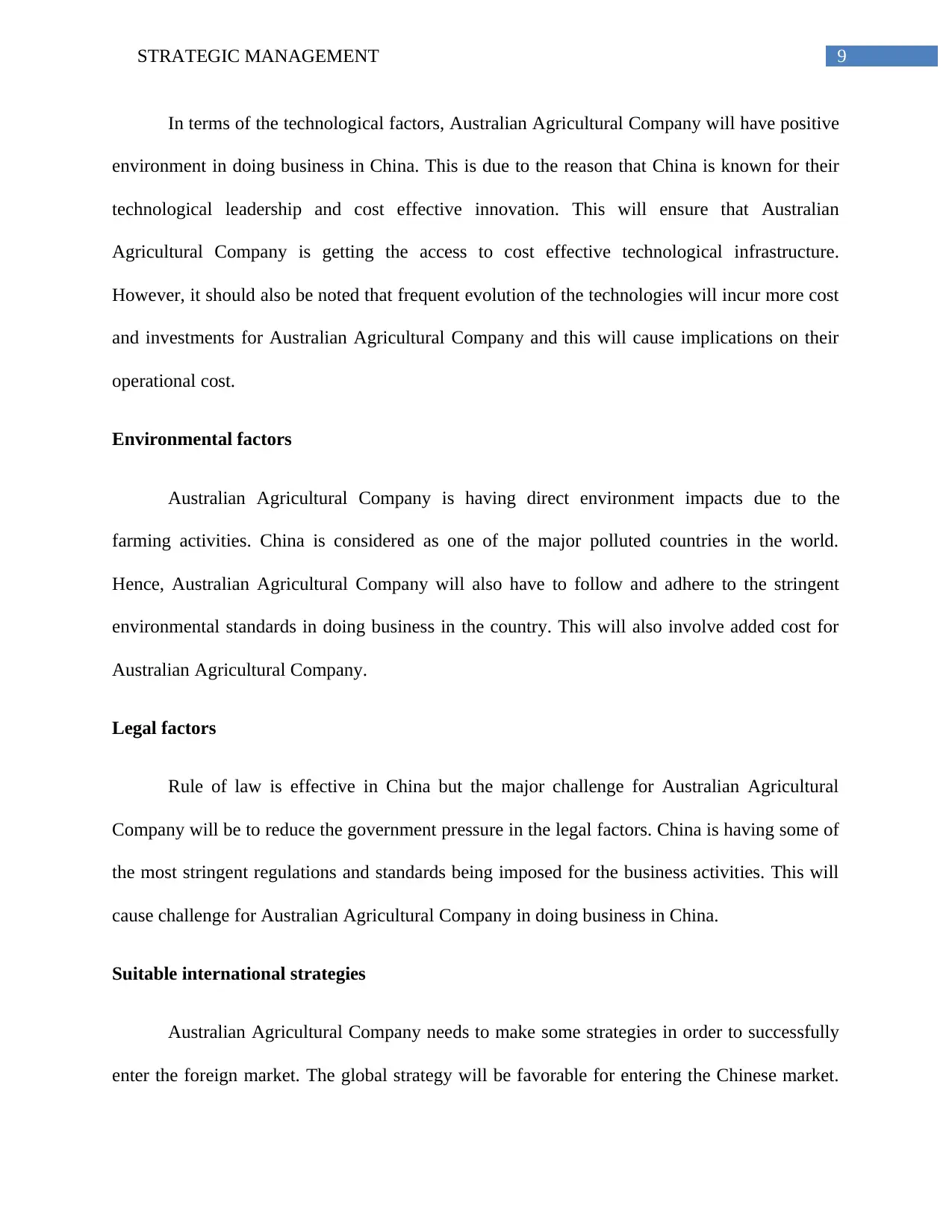
9STRATEGIC MANAGEMENT
In terms of the technological factors, Australian Agricultural Company will have positive
environment in doing business in China. This is due to the reason that China is known for their
technological leadership and cost effective innovation. This will ensure that Australian
Agricultural Company is getting the access to cost effective technological infrastructure.
However, it should also be noted that frequent evolution of the technologies will incur more cost
and investments for Australian Agricultural Company and this will cause implications on their
operational cost.
Environmental factors
Australian Agricultural Company is having direct environment impacts due to the
farming activities. China is considered as one of the major polluted countries in the world.
Hence, Australian Agricultural Company will also have to follow and adhere to the stringent
environmental standards in doing business in the country. This will also involve added cost for
Australian Agricultural Company.
Legal factors
Rule of law is effective in China but the major challenge for Australian Agricultural
Company will be to reduce the government pressure in the legal factors. China is having some of
the most stringent regulations and standards being imposed for the business activities. This will
cause challenge for Australian Agricultural Company in doing business in China.
Suitable international strategies
Australian Agricultural Company needs to make some strategies in order to successfully
enter the foreign market. The global strategy will be favorable for entering the Chinese market.
In terms of the technological factors, Australian Agricultural Company will have positive
environment in doing business in China. This is due to the reason that China is known for their
technological leadership and cost effective innovation. This will ensure that Australian
Agricultural Company is getting the access to cost effective technological infrastructure.
However, it should also be noted that frequent evolution of the technologies will incur more cost
and investments for Australian Agricultural Company and this will cause implications on their
operational cost.
Environmental factors
Australian Agricultural Company is having direct environment impacts due to the
farming activities. China is considered as one of the major polluted countries in the world.
Hence, Australian Agricultural Company will also have to follow and adhere to the stringent
environmental standards in doing business in the country. This will also involve added cost for
Australian Agricultural Company.
Legal factors
Rule of law is effective in China but the major challenge for Australian Agricultural
Company will be to reduce the government pressure in the legal factors. China is having some of
the most stringent regulations and standards being imposed for the business activities. This will
cause challenge for Australian Agricultural Company in doing business in China.
Suitable international strategies
Australian Agricultural Company needs to make some strategies in order to successfully
enter the foreign market. The global strategy will be favorable for entering the Chinese market.
Paraphrase This Document
Need a fresh take? Get an instant paraphrase of this document with our AI Paraphraser
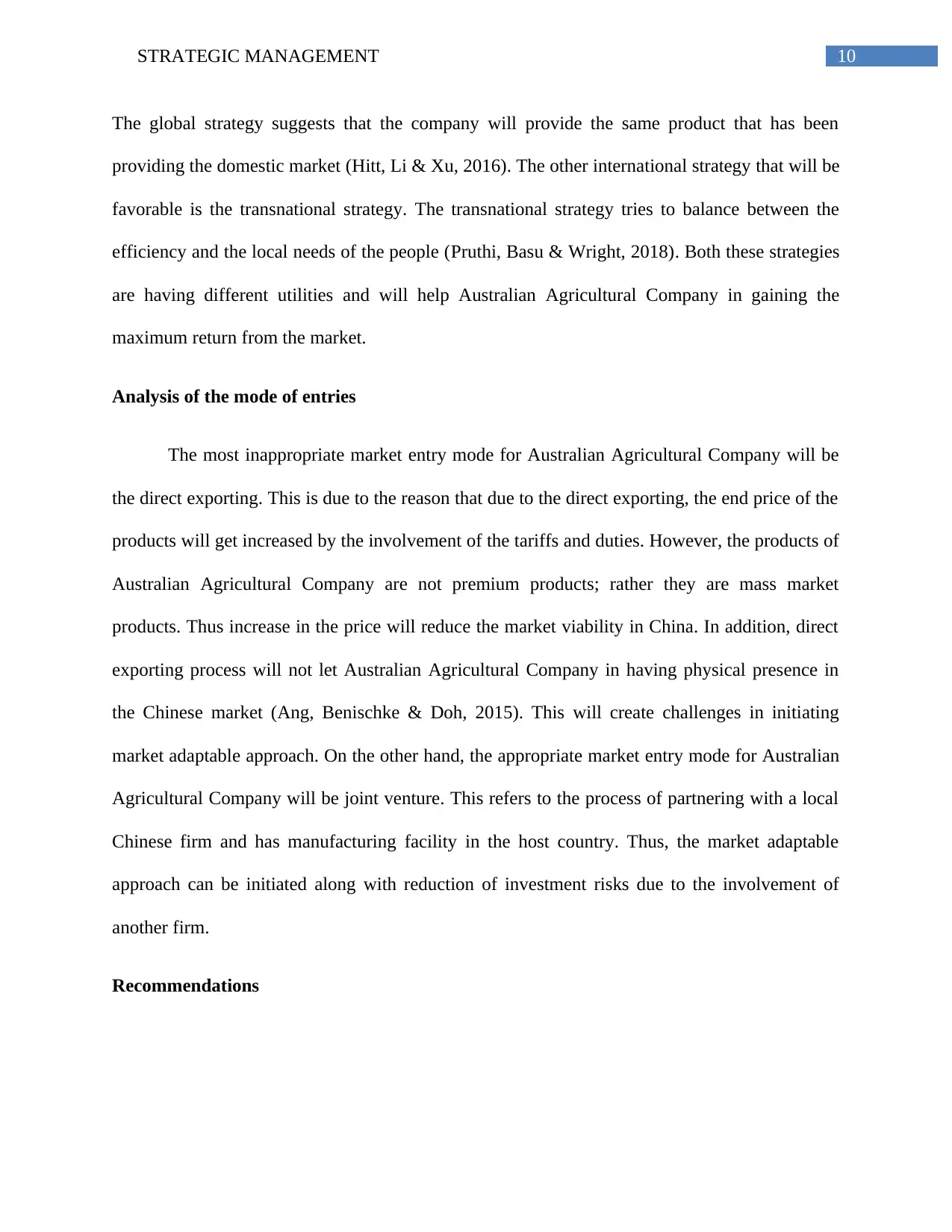
10STRATEGIC MANAGEMENT
The global strategy suggests that the company will provide the same product that has been
providing the domestic market (Hitt, Li & Xu, 2016). The other international strategy that will be
favorable is the transnational strategy. The transnational strategy tries to balance between the
efficiency and the local needs of the people (Pruthi, Basu & Wright, 2018). Both these strategies
are having different utilities and will help Australian Agricultural Company in gaining the
maximum return from the market.
Analysis of the mode of entries
The most inappropriate market entry mode for Australian Agricultural Company will be
the direct exporting. This is due to the reason that due to the direct exporting, the end price of the
products will get increased by the involvement of the tariffs and duties. However, the products of
Australian Agricultural Company are not premium products; rather they are mass market
products. Thus increase in the price will reduce the market viability in China. In addition, direct
exporting process will not let Australian Agricultural Company in having physical presence in
the Chinese market (Ang, Benischke & Doh, 2015). This will create challenges in initiating
market adaptable approach. On the other hand, the appropriate market entry mode for Australian
Agricultural Company will be joint venture. This refers to the process of partnering with a local
Chinese firm and has manufacturing facility in the host country. Thus, the market adaptable
approach can be initiated along with reduction of investment risks due to the involvement of
another firm.
Recommendations
The global strategy suggests that the company will provide the same product that has been
providing the domestic market (Hitt, Li & Xu, 2016). The other international strategy that will be
favorable is the transnational strategy. The transnational strategy tries to balance between the
efficiency and the local needs of the people (Pruthi, Basu & Wright, 2018). Both these strategies
are having different utilities and will help Australian Agricultural Company in gaining the
maximum return from the market.
Analysis of the mode of entries
The most inappropriate market entry mode for Australian Agricultural Company will be
the direct exporting. This is due to the reason that due to the direct exporting, the end price of the
products will get increased by the involvement of the tariffs and duties. However, the products of
Australian Agricultural Company are not premium products; rather they are mass market
products. Thus increase in the price will reduce the market viability in China. In addition, direct
exporting process will not let Australian Agricultural Company in having physical presence in
the Chinese market (Ang, Benischke & Doh, 2015). This will create challenges in initiating
market adaptable approach. On the other hand, the appropriate market entry mode for Australian
Agricultural Company will be joint venture. This refers to the process of partnering with a local
Chinese firm and has manufacturing facility in the host country. Thus, the market adaptable
approach can be initiated along with reduction of investment risks due to the involvement of
another firm.
Recommendations
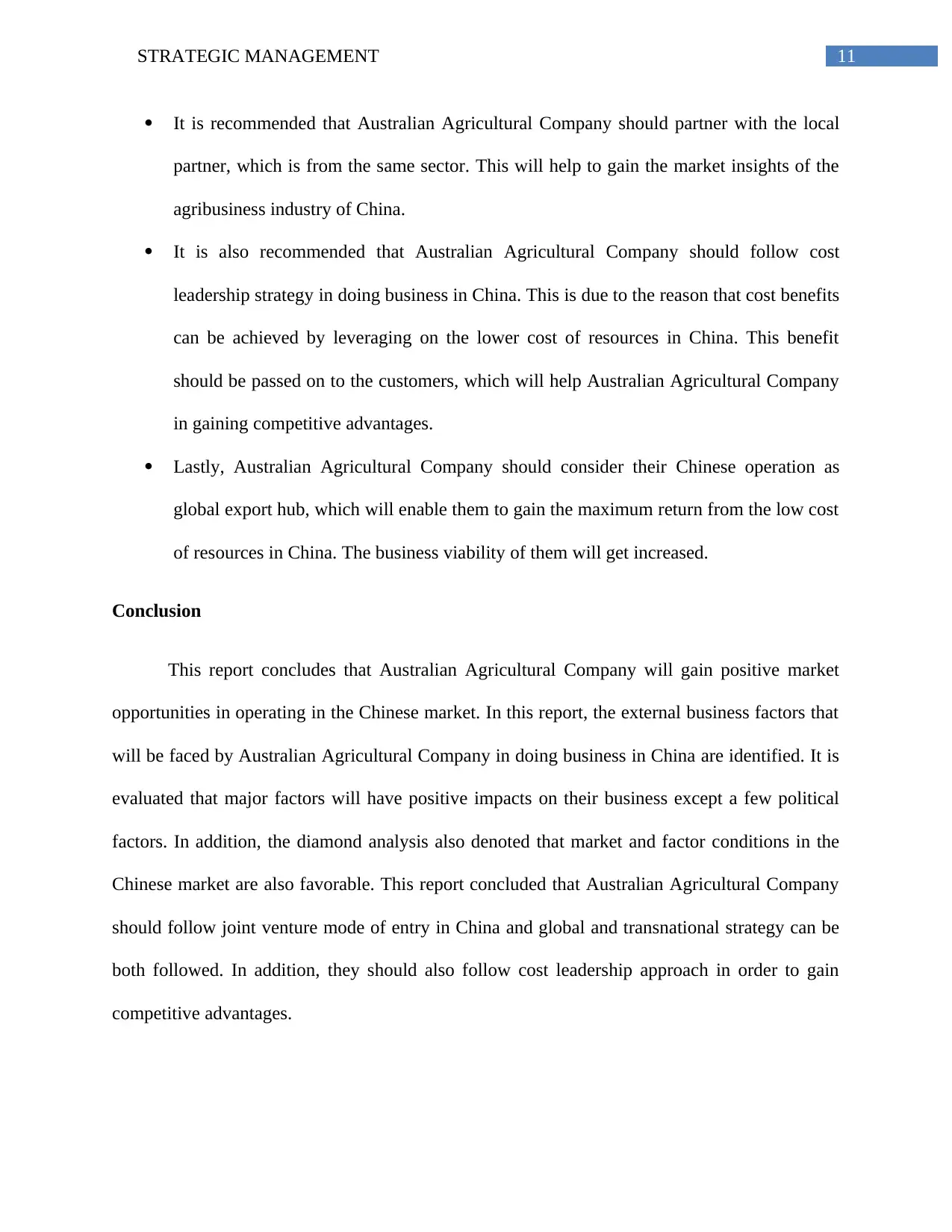
11STRATEGIC MANAGEMENT
It is recommended that Australian Agricultural Company should partner with the local
partner, which is from the same sector. This will help to gain the market insights of the
agribusiness industry of China.
It is also recommended that Australian Agricultural Company should follow cost
leadership strategy in doing business in China. This is due to the reason that cost benefits
can be achieved by leveraging on the lower cost of resources in China. This benefit
should be passed on to the customers, which will help Australian Agricultural Company
in gaining competitive advantages.
Lastly, Australian Agricultural Company should consider their Chinese operation as
global export hub, which will enable them to gain the maximum return from the low cost
of resources in China. The business viability of them will get increased.
Conclusion
This report concludes that Australian Agricultural Company will gain positive market
opportunities in operating in the Chinese market. In this report, the external business factors that
will be faced by Australian Agricultural Company in doing business in China are identified. It is
evaluated that major factors will have positive impacts on their business except a few political
factors. In addition, the diamond analysis also denoted that market and factor conditions in the
Chinese market are also favorable. This report concluded that Australian Agricultural Company
should follow joint venture mode of entry in China and global and transnational strategy can be
both followed. In addition, they should also follow cost leadership approach in order to gain
competitive advantages.
It is recommended that Australian Agricultural Company should partner with the local
partner, which is from the same sector. This will help to gain the market insights of the
agribusiness industry of China.
It is also recommended that Australian Agricultural Company should follow cost
leadership strategy in doing business in China. This is due to the reason that cost benefits
can be achieved by leveraging on the lower cost of resources in China. This benefit
should be passed on to the customers, which will help Australian Agricultural Company
in gaining competitive advantages.
Lastly, Australian Agricultural Company should consider their Chinese operation as
global export hub, which will enable them to gain the maximum return from the low cost
of resources in China. The business viability of them will get increased.
Conclusion
This report concludes that Australian Agricultural Company will gain positive market
opportunities in operating in the Chinese market. In this report, the external business factors that
will be faced by Australian Agricultural Company in doing business in China are identified. It is
evaluated that major factors will have positive impacts on their business except a few political
factors. In addition, the diamond analysis also denoted that market and factor conditions in the
Chinese market are also favorable. This report concluded that Australian Agricultural Company
should follow joint venture mode of entry in China and global and transnational strategy can be
both followed. In addition, they should also follow cost leadership approach in order to gain
competitive advantages.
⊘ This is a preview!⊘
Do you want full access?
Subscribe today to unlock all pages.

Trusted by 1+ million students worldwide
1 out of 14
Related Documents
Your All-in-One AI-Powered Toolkit for Academic Success.
+13062052269
info@desklib.com
Available 24*7 on WhatsApp / Email
![[object Object]](/_next/static/media/star-bottom.7253800d.svg)
Unlock your academic potential
Copyright © 2020–2025 A2Z Services. All Rights Reserved. Developed and managed by ZUCOL.





